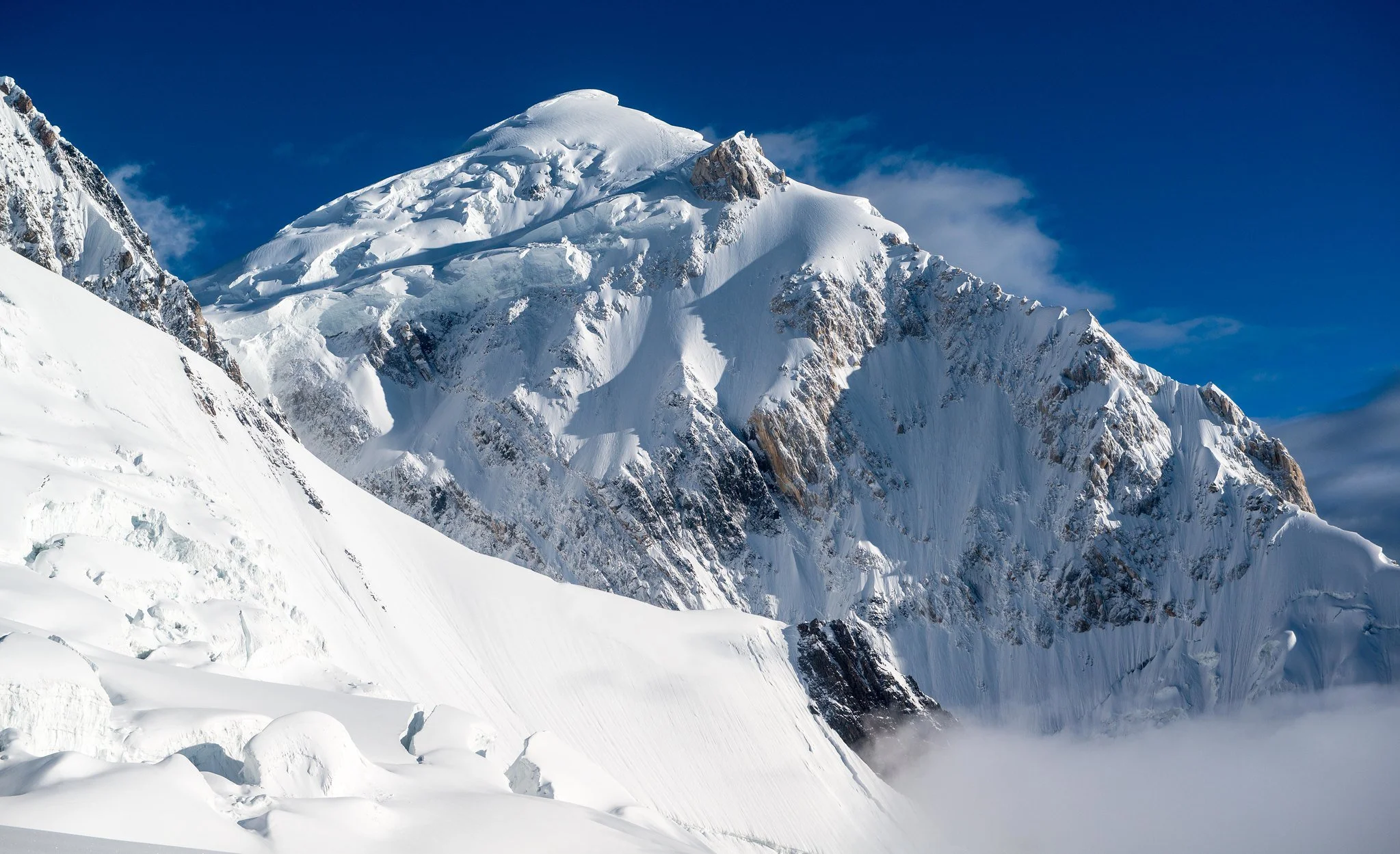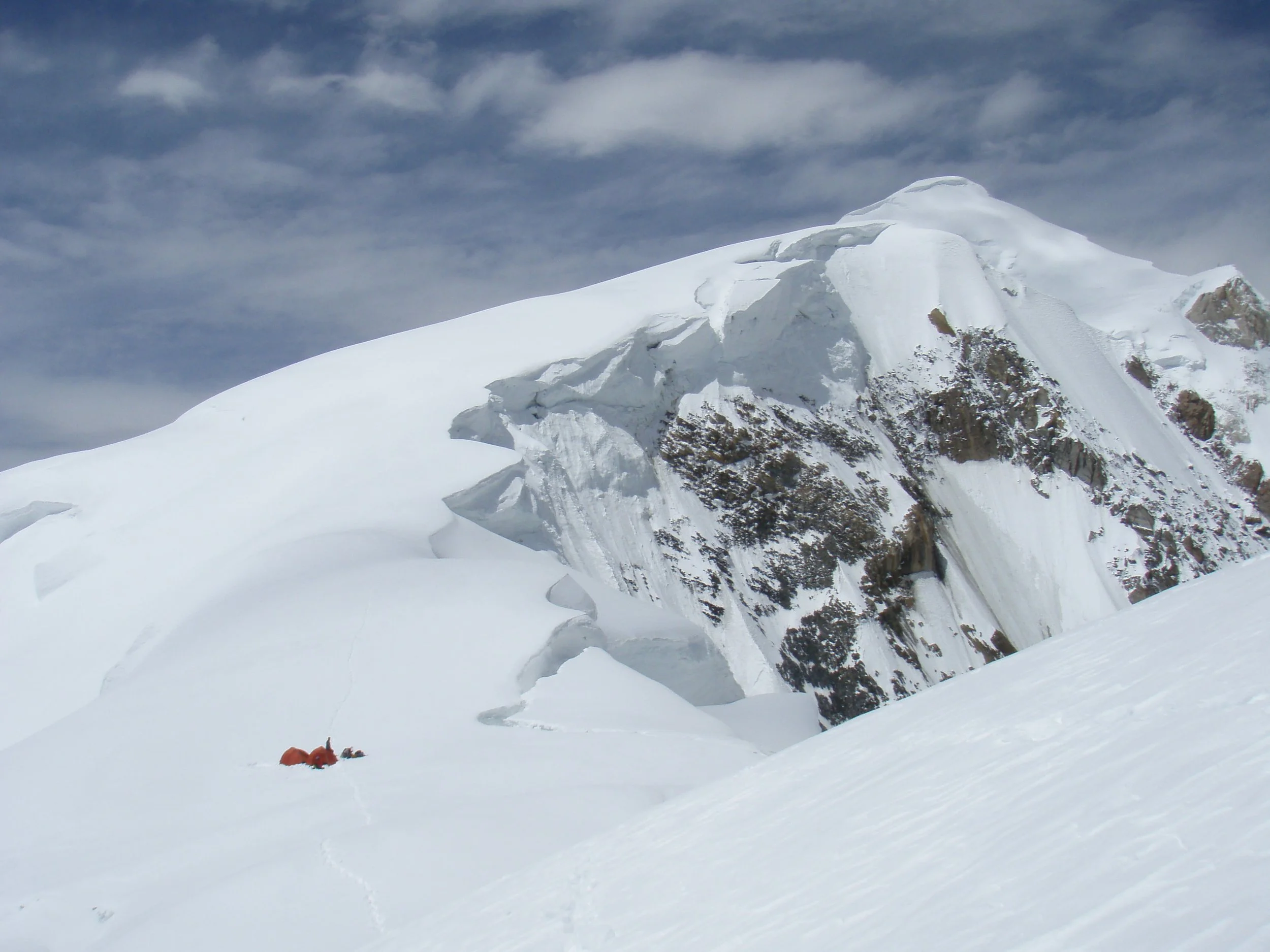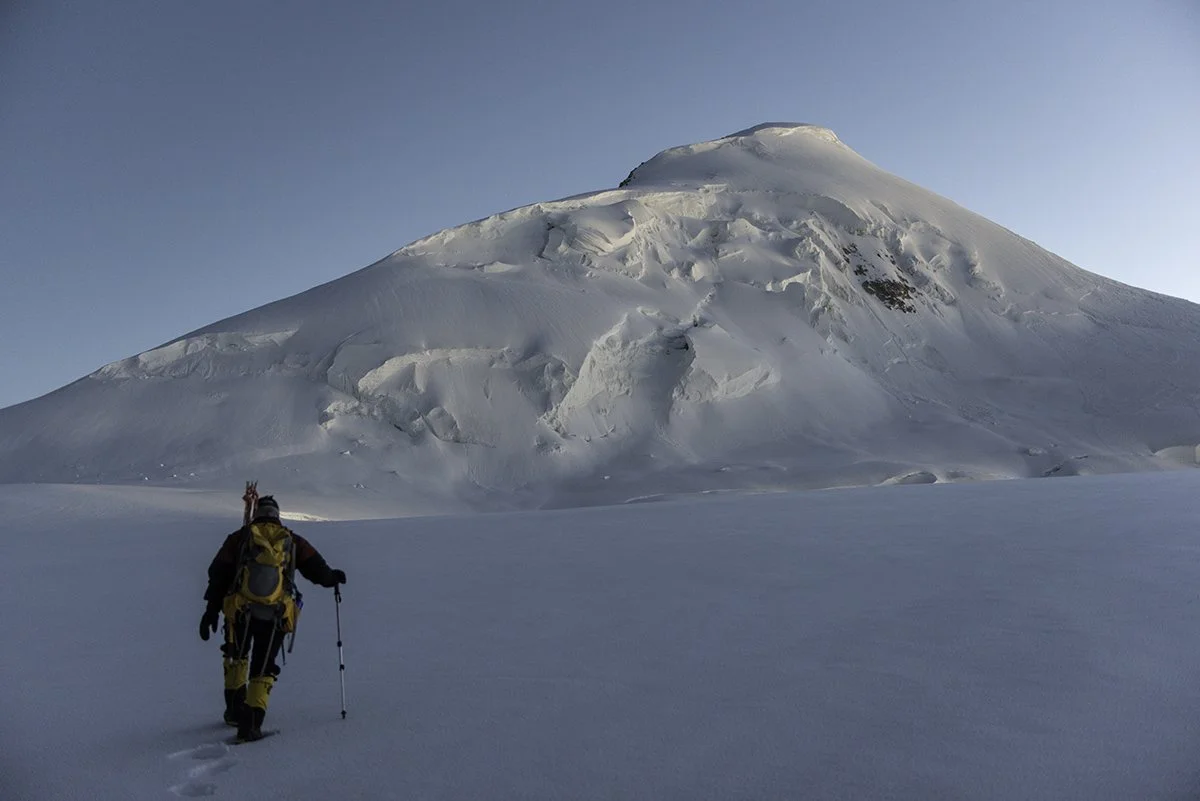
spantik 7027M
HIGHLiGHTS
Straight forward entry level 7000M in the Karakoram
1:3 guided expedition with 1:1 local HAP. Small team strategy. 12 max client members
16 Weeks of training programs for 8000M from Training Peaks
Low objective risk: Fewer seracs and avalanche threats compared to more technical Karakoram peaks.
Classic Karakoram journey: Fly into Islamabad → Skardu, trek through remote valleys, and climb in a less‑travelled region.
Unforgettable summit views: 360° panoramas—see Nanga Parbat, K2, and the Baltoro range from the top.
OVERVIEW
Climb the stunning Spantik (7,027 m) in the heart of the Karakoram—perfect for experienced mountaineers looking to step up from 6000 m peaks to a non‑technical yet majestic 7000 m ascent. Our route follows the beautiful, low‑angle South East Ridge, stretching over 8 km with just short 30–40° snow slopes. With minimal objective danger and fixed camps, this expedition offers a dramatic alpine challenge without the technical hazards.
Location: East of Skardu, Nagar Valley, Karakoram, Pakistan
Route: South East Ridge — predominantly snow ridge, straightforward glacier travel
Duration: 28 days
Group Size: Maximum 10 climbers
Best Time to Climb: June - August
Support: 1:3 Sherpa ratio, 1:1 High altitude local Pakistan porter support. Full expedition support, safety protocols
Pre-requisite requirements (one or more 4000M - 6000M+ experiences): 6000M - Lobuche East & Island Peak, Chulu West, Khumbu 3 Peak expeditions, Annapurna three peak, Ama Dablam etc.
-
2026
21st June - 17th July (9 spots left)
12th July - 8th August. (9 spots left)
(Minimum of 5 bookings required to run this expedition)
-
USD 7,950 P/P
Deposit: USD 500 p/p
For 1:1 Guided expedition please inquire for quote.
We accept payment in £GBP/ €EUROS/ $AUD
-
1:3 guide ratio. Lead by Nepalese Guide with 8000M and several 6000M, 7000M guided experiences.
1:1 High altitude local Pakistan porter
16 Weeks of training programs for 7000M from Training Peaks
Head chef and 2 kitchen helpers (Helpers increase with the number of climbing team members)
Emergency supplemental oxygen
1 night before the expedition and 1 day after the expedition. Hotel in Islamabad and Skardu. (Should clients return early from their expedition, clients will be responsible for their extra hotel bookings)
All trekking and climbing permits
All internal-local transportation to and from the trekking trailhead
Solo tent at BC, and 2-person tent at higher camps
45 kgs personal weight (Extra additional weight, clients will need to hire an additional porter. Estimated USD 1500)
Meals during camping days (Non-veg and veg options, etc)
Burners and expedition equipment
Walkie-talkie/ Satellite phone/wifi at base camp
Breakfast, Lunch, and Dinner on trek and expedition days.
Lodge accommodation during the trek
Porters services
Arrival pick-up and departure
Internal flights
Full Expedition First aid kit and high-altitude medicines
Welcome or Farewell leave Dinner
-
Visas and travel insurance
Summit Bonus ($500+ per member)
Entertainment and food
Bottled drinks and beverages
Evacuation (will be done in your account)
Laundry, Phone services, Personal expenditure transactions
Optional trips
Tea breaks, chocolates or other snacks, and any meals besides breakfast, lunch, and dinner.
Delay and cancellation because of natural phenomenon
International flights
ITINERARY
Day 1 Arrival day in Islamabad
Day 2 Fly to Skardu (2,500 m). Acclimatize, gear check, and cultural brief at local K2 Hotel.
Day 3 Jeep transfer to Arandu (2,720 m), begin trek.
Day 4 Arandu → Chogo Brangsa (3,400 m)
Day 5 Bolocho (3,820 m)
Day 6 Arrive Base Camp (4,360 m)
Day 7 Rest & Puja day
Days 8–24: Climbing days (Backup summit days built into itinerary for flexibility and weather contingencies). Expedition strategy, bottom of the page. Khare acclimatisation Hike Mera La to Kongma Dingma
Day 25 Return to basecamp, pack and rest.
Day 26 Trek back to Arandu, jeep to Skardu
Day 27 Fly Skardu → Islamabad
Day 28 Departure
-
For additional peronal Sherpa guide please contact our office
Extra Oxygen bottle $1500 per bottle
HOW DOES IT WORK?
1. Initial Inquiry and Planning
At NAMAS Adventure, we start by understanding your aspirations and goals. From your first conversation with our expert team, we provide personalized recommendation tailored to your interests. Once the perfect expedition is identified, a deposit secures your spot. We then work closely with you to plan and prepare every detail—from gear selection and training advice to arranging insurance, permits, and logistics.
2. Preparing for the Journey
As your expedition date approaches, we’ll help you finalize all preparations. This includes collecting the final balance payment (typically due 60-90 days before your trip), ensuring all necessary documents are in order, and addressing any remaining questions. Our team is available via email or phone calls to make sure you’re fully prepared and confident for the adventure ahead.
3. On-Expedition Support
Arrive at your destination ready to begin! From pre-expedition briefings and gear checks to the full support of our experienced guides and ground team during your climb, we’re here to ensure everything runs smoothly. With flexibility to adapt to any changes or needs, we’re committed to making your adventure seamless, enjoyable, and unforgettable

Expedition strategy
Climbing Spantik (7,027 m) via the South East Ridge is a classic high-altitude progression. Our strategy is built around gradual acclimatization, efficient camp setups, and smart weather timing—all designed to maximize your summit chances while minimizing risk.
Base Camp (4,360 m): Acclimatization & Preparation - We spend the first full day at base camp to rest, acclimatize, and review safety protocols.
Light acclimatization hikes
Gear check, rope work refresher, and team briefing
Views of the full 8km South East Ridge from camp
We don’t rush this phase—proper rest here sets up your entire climb.
Camp 1 (5,100 m): Establish the Climb - We ascend gradually from base camp along snow and scree slopes, following glacial moraines and low-angle terrain to reach Camp 1.
Snow ramps with occasional crevasse navigation
No fixed lines needed unless fresh snow complicates the route
Sherpa team carries group equipment and helps establish tents
Load carry days may be used here to cache gear
We monitor oxygen saturation daily to assess acclimatization.
Camp 2 (5,650 m): Transition to the Upper Ridge - The route becomes more sustained as we move onto the broader spine of the South East Ridge.
Longer snow ridge walking, increasing exposure
Occasional use of fixed rope in wind-exposed or icy sections
Great vantage point to preview the summit pyramid
Winds can pick up—weather windows are critical from here on
Camp 2 offers some of the most dramatic sunrise views of the entire Karakoram.
Camp 3 (6,250 m): Summit Launch Pad - This is our final high camp, set on a sheltered section of the ridge.
Shorter day from Camp 2, but increasingly demanding due to altitude
Camp is carefully selected to protect from wind and avalanche zones
Final gear checks and mental prep for the summit
We aim to reach Camp 3 strong, with a rest period before summit night.
Summit Day (7,027 m): Long Ridge to Glory - We begin our summit push in the early hours (typically around 1–2 AM).
Long snow ridge ascent: 700–800 vertical metres over 4–6 hours
No major technical sections—mostly snow walking, with occasional fixed lines for security
The final approach narrows slightly but remains non-technical
From the summit, expect incredible panoramic views:
To the east: Baltoro giants, including K2
To the west: Hunza, Batura, and Rakaposhi
To the south: Nanga Parbat, rising alone on the western fringe
We aim to summit and return to Camp 2 or Camp 3 by early afternoon, depending on conditions and team strength.
Descent Strategy - Descent is staged over 1–2 days based on team strength and weather.
Most teams descend from Camp 3 to Camp 1 in a single day
All group and personal gear is removed—Namas expeditions leave no trace
We rest at base camp before the return trek begins
Emergency Planning - In case of altitude illness or injury:
Sherpa team trained in high-altitude first aid
Helicopter evacuation coordination from base camp (weather permitting)
Daily health check-ins, including O2 saturation and AMS scoring



